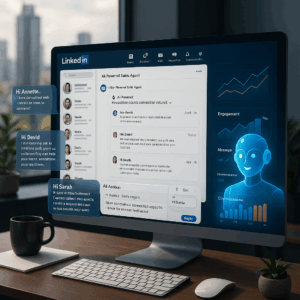As we continue in the digital age, the way we create and consume content is in constant evolution. One of the most significant technological advancements lately is AI, and its applications in content creation are truly groundbreaking.
This extensive guide will take you through the revolution of AI in content generation and explore what the future holds for this innovative technology.

As we tread further into the digital frontiers of the 21st century, our way of perceiving, curating, and disseminating content is fast evolving. At the forefront of this massive shift is none other than the powerful technology of AI. For the uninitiated, AI seems to be a concept straight out of a science fiction movie, but it is very real and is making tangible differences in our daily lives, from automated customer service to personalized Netflix recommendations, and much more. And now, it has started to profoundly shape the realm of writing and content creation.
AI’s role in content generation cannot be understated. Whether it’s in creating social media posts, drafting emails, or even generating novel-length texts, AI is making waves in myriad industries. This transition isn’t just about replacing humans with robots or machines, but it’s about enhancing the creativity and efficiency of writers, making it possible to generate unique, high-quality, and data-driven content in a fraction of the time it once took. So tighten your seatbelts as we take a deep dive into the fascinating world of AI content generation – a world full of promise, innovation, and unprecedented possibilities. Buckle up, as we steer towards a digital revolution that’s set to change content creation as we know it.
What is AI Content Generation?
Put simply, AI content generation refers to the process where AI systems or software utilize algorithms and predictive analytics to generate content. This content can span various genres, from blog posts and news articles to more complex writings, such as academic reports and even books.
The AI-driven content generation isn’t magic, though sometimes it might seem that way owing to its impressive outcomes. It leans on two core technologies: Natural Language Processing (NLP) and Machine Learning (ML). NLP, a branch of AI, helps the machines understand, interpret, respond in, and generate human language in a valuable and meaningful way. This includes tasks like translation, sentiment analysis, and topic recognition.
On the other hand, Machine Learning, another subset of AI, grants the machines the ability to learn from and improve upon experiences without being manually programmed. In the context of content generation, AI is trained on vast amounts of text data. It learns patterns, styles, structures, tones, and more from this data. Over time and with enough exposure, the system can generate content that mimics the depth and nuance of human language.
What’s fascinating is that these technologies behind AI content generation aren’t stagnant. They continue to evolve, and the farther down the rabbit hole we go, the more we understand their true capabilities and potential. This section is just the tip of the iceberg when it comes to understanding AI content generation. Throughout the rest of this article, we’ll delve deeper into just how impactful and game-changing this technology can be.
The Rise of AI in Content Generation
Just like the introduction of print press revolutionized how information was disseminated centuries ago, the evolution and increased adoption of AI content generation is rewriting the rules of content creation.
AI-based content generation tools made their entrance into the mainstream market only a few years back but have gained immense traction in a short period of time. Remember when Autocorrect made us question every spelling we were unsure of? Or when Grammarly started showing us our grammatical mistakes? Now, AI has moved beyond grammar nannies and autocorrect pests to creative writing collaborators.
AI’s growth in the content generation market can be traced back to the increasing demand for fresh, unique content. Businesses are pumping out more content than ever before and the push for high-quality, engaging content intensified with the rise of the internet.
One significant reason for AI content generation’s ascent is the omnipresence of data. AI relies on vast databases of information to generate content, and the exponential growth of data availability in the digital age has given AI the fodder it needed to thrive.
Now, let’s bow down to some of the key players making waves in the AI content generation market. Companies such as OpenAI, creators of the noteworthy GPT-3, and Google’s BERT have been pushing the envelope on what machines can create. These advanced systems can generate human-like text, right down to matching a specific writing style or tone.
It’s not just the tech giants making a mark, though. Start-ups like AI21 Labs and Persado have been shaking things up with tools that create human-like text, while apps like Jarvis have made AI writing more accessible to individual users.
The rise of AI is a testament to technology’s boundless potential. With the valor of innovators propelling the AI content generation market forward, the world of writing is transmuting before our eyes. From drafting emails to scripting eCommerce product descriptions, AI is pushing the boundaries of what’s possible in content generation. Stay tuned as we continue to chart the narrative of this thrilling technological journey.

How AI is Transforming Content Creation
AI is revolutionizing the content creation sphere in full and thrilling strides. Not only is it redrawing the traditional guidelines of writing and editing processes, but it is also reshaping the whole creative paradigm.
Enhanced Content Generation Speed
One of the significant effects of AI in content creation is on speed. The key points are:
- AI enables faster generation of writing compared to conventional methods.
- It allows creators to allocate more time for ideation and strategy.
- It provides a constant output, functioning ceaselessly without breaks.
Diverse Content and Tonal Adaptability
AI changes color according to the type of content and tone needed:
- It can produce various content forms, like product descriptions, blogs, detailed reports.
- AI algorithms can adapt to various writing styles and tones, providing a human touch.
Creating Original Artistic Works
AI is not confined to traditional writing patterns:
- It experiments by creating artistic pieces like poems, song lyrics and screenplay drafts.
- The concept might sound like sci-fi, but AI’s creative potential is fast evolving.
High Degree of Personalization
AI is revolutionizing personalization in content:
- It creates custom-made content that directly addresses the reader’s needs and behaviors.
- Personalization makes every piece of content appear finely carved for each reader.
Precision and Data-driven Content
AI’s relation with data is synergistic:
- AI leverages data-driven insights to enhance the accuracy, relevance and quality of content.
Overcoming Language Barriers
AI is making strides in language translation:
- AI-powered translators are enabling precise translation and reformatting for various languages.
- It’s making content universally accessible.
Conclusion
The transformation of content creation through AI heralds a brave new world. Though not perfect, the evolving collaboration of human creativity with AI signals a future promising greater depth, breadth, and impact for our collective narratives.
Pros and Cons of AI Content Generation
In the ever-evolving landscape of content creation, AI stands as both a vanguard and a subject of debate when it comes to benefits and drawbacks.
One of the biggest pros of using AI in content creation is the massive efficiency boost. For businesses churning out regular content, AI content generation can be a game-changer, enabling them to produce a high volume of quality content at breakneck speed. No more caffeine-dependent late nights at the office or missing deadlines because the team’s human content generator called in sick.
AI is also adept at analyzing vast amounts of data to predict trends and tailor content to accommodate these insights. Imagine content that’s not only relevant but also viral-worthy, delivered in a flash to your target audience’s feeds.
The technology’s ability to create diverse content is another plus, as it draws from a colossal pool of resources – the Internet. You get top-notch content on various topics, in several different styles. This talent pool, no doubt, beats a room of human minds limited by individual experiences and knowledge.
However, like a coin, AI content generation has its other side. The firmer grip AI takes on content creation, the greater our reliance becomes, making it a potential hazard. Dependence on a tech that’s still evolving can disrupt workflows when unexpected errors or changes occur.
Another downside is the threat to jobs. Robots taking over human positions is a narrative we’re all familiar with, and it is no different here. However, this prompts the argument of focusing human creativity on more strategic tasks while the hectic, repetitive work is handled by AI.
Furthermore, despite AI’s impressive advancements, it still lacks one crucial human attribute – empathy. It might be perfect at identifying viral trends and adapting to them, but the technology can still fall short in capturing human emotions and values within its content, something that resonates strongly with audiences.
Lastly, there is the ethical concern when it comes to AI crafting misinformation or ‘deep fake’ content. With access to such a wealth of online resources, there are risks that AI might generate and distribute content that is misleading or downright false.
Understanding these pros and cons is essential for any user or business considering adopting AI content generation. Just as with any tool, it’s about making it work for us, not becoming slaves to its potential shortcomings.

Case Studies: Successful AI Content Generation
To further illustrate the efficacy of artificial intelligence in content generation, let’s dissect a couple of concrete examples that bear witness to the successful integration of AI in this creative domain.
Our first example springs from the world of journalism, where AI has taken a strong foothold. The Associated Press (AP), a notable newswire globally, began using Automated Insights’ AI tool, “Wordsmith,” back in 2015. This tool was employed in generating financial news and corporate earnings reports which usually require substantial time and manpower. The outcome was staggering: The AP was able to increase their content production from 300 reports to a whopping 3,000 – a 10-fold augmentation. Importantly, the quality of reporting remained firmly intact, and errors, in fact, reduced since the AI tool could analyze massive data sets with pinpoint accuracy.
Our second case study focuses on content marketing, as we turn our eyes to Persado. This AI-powered tool specializes in creating engaging marketing content that boosts conversions. Experian, a global information services group, decided to test run Persado for the creation of their email subject lines. The result? An impressive uplift of 50% more unique open rates compared to human-generated subject lines. Persado’s knack for selecting impactful words and phrases greatly increased customer engagement, leading to a significantly improved marketing outcome.
These instances, albeit atomic, collectively showcase the unarguable power of AI content generation. They exhibit that AI can not only speed up the content creation process but also enhance content quality, even in areas like journalism and content marketing where human creativity has principally been considered paramount. This beautiful marriage of technology and content demonstrates that AI is not poised to replace humans, but rather to augment their capabilities, providing us with more time to focus on intricate tasks while AI handles the heavy data lifting.
Future of AI in Content Creation
How much further can the extraordinary world of AI soar within the bounds of content creation? The prospects are as infinite as they are enthralling. As futuristic as it seems, we are just at the cusp of understanding the true potential of artificial intelligence in content generation. With ongoing technological advancements, the upcoming years shine exceedingly bright for the AI-driven writing landscape.
Consider the concept of AI content personalization. With this, businesses might soon be able to offer profoundly personalized content to their consumers. AI can analyze individuals’ interaction patterns, preferences, and consumption habits, then use this data to create uniquely tailored content. This level of personalized interaction could fortify customer relationships and drastically enhance user experience.
Narrative science, a future-forward domain, also stands on the horizon. Envisage AI technologies effectively generating resonant, compelling narratives, relieving writers from the time-consuming intricacy of storytelling. It’s the stuff of zeitgeist classics but could very well be a shared reality soon.
The potential integration of AI with augmented reality (AR) and virtual reality (VR) in content creation presents another captivating frontier. Imagine immersive storytelling with the aid of AI, creating hyper-realistic experiences that transport readers to another realm.
Lastly, the union of AI and blockchain technology could offer superior protection to AI-based generated content, ensuring creators’ rights and potentially solving copyright issues in the digital world.
Each of these prospects comes with its challenges, of course. AI’s further involvement in our daily lives raises important ethical and data privacy issues. But, with careful, regulatory navigation, the benefits outweigh the risks.
Remember, we’re living in an era that walks hand-in-hand with the rise of AI. The next coming years hold the promise of designs, breakthroughs, and advancements we can scarcely imagine. In terms of the future of AI in content creation, it’s safe to say: we’ve only just begun.
Conclusion
As we conclude this deep-dive into the groundbreaking field of AI content generation, let’s reflect on the key points we tackled. We sauntered across its riveting concept, elaborating on how technologies like natural language processing and machine learning interplay to create AI-generated content. We traveled through the rise of AI in content creation, observing significant players and their unique contributions to this innovation.
We also examined how AI is steadily transforming the cotton fabric of content creation—speeding up the writing process, diversifying content output, and more. Like any technology, AI content generation stands on the balancing beam of advantages and challenges, yet its potential for growth and development seems promising.
The case studies we went through brought to life the successful implementation of AI in content creation, further strengthening the belief in its utility and potential. And as we looked into the not-so-distant future, we highlighted the potential changes and advancements AI might bring, painting a fascinating yet realistic picture of what content creation might look like for us in the next few years.
Now, it’s perfectly normal if you harbor questions or concerns about AI content generation. It’s a burgeoning technology, and like every innovation, it brings along change – an element often met with both anticipation and reservation. Yet, as we march further into the digital age, technologies like these stand poised to serve as powerful tools that can redefine norms and elevate efficiency and creativity.
In the end, it’s essential to remember that AI, like any tool, is as effective as the hands that wield it. As we unveil the future of writing, let’s ensure to use AI content generation not as a replacement but as a robust ally that caters to our evolving needs in this ever-changing digital landscape. So gear up and embrace the future, as the next chapter of content creation promises to be an exciting one indeed.
Stay Connected with InnovareAI!
Want to stay up-to-date on the latest AI advancements and how they can benefit your business? Follow InnovareAI on social media!
LinkedIn: https://www.linkedin.com/company/innovare-ai
On our social media channels, you’ll find:
- Engaging content: Learn about AI trends, case studies, and expert insights.
- Exclusive updates: Be the first to know about new product launches, webinars, and events.
- Interactive discussions: Join the conversation and share your thoughts on the future of AI.
- Valuable resources: Access white papers, ebooks, and other helpful materials.
Don’t miss out! Follow InnovareAI today and unlock the power of AI for your business.



